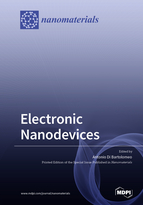Electronic Nanodevices
A special issue of Nanomaterials (ISSN 2079-4991). This special issue belongs to the section "Nanoelectronics, Nanosensors and Devices".
Deadline for manuscript submissions: closed (28 February 2022) | Viewed by 42177
Special Issue Editor
Interests: optical and electrical properties of nanostructured materials such as carbon nanotubes, graphene, and 2D materials; van der Waals heterostructures and Schottky junctions; field-effect transistors; non-volatile memories; solar cells; photodetectors; field emission devices
Special Issues, Collections and Topics in MDPI journals
Special Issue Information
Dear Colleagues,
The start of high-volume production of field-effect transistors with a feature size below 100 nm at the end of the 20th century signaled the transition from microelectronics to nanoelectronics. Since then, downscaling in the semiconductor industry has continued until the recent development of sub-10 nm technologies.
Although the basic operating principles of transistors have remained more or less the same during the transition to the nanoscale regime, several phenomena related to the wave nature of electrons have gradually appeared, and some traditional issues, such as short-channel effects, junction or dielectric leakages, have become more severe. Tunneling and other quantum effects or fluctuations in several transistor parameters due to the granularity of matter have become more relevant.
The new phenomena and issues as well as the technological challenges of the fabrication and manipulation at the nanoscale have spurred an intense theoretical and experimental research activity. New device structures, operating principles, materials, and measurement techniques have emerged, and new approaches to electronic transport and device modeling have become necessary. Examples are the introduction of vertical MOSFETs in addition to the planar ones to enable the multigate approach as well as the development of new tunneling, high-electron mobility, and single-electron devices. The search for new materials such as nanowires, nanotubes, and 2D materials for the transistor channel, dielectrics, and interconnects has been part of the process.
Other than for integrated circuits, new electronic nanodevices, often consisting of nanoscale heterojunctions, have been developed for light emission, transmission, and detection in optoelectronic and photonic systems, as well for new chemical, biological, and environmental sensors.
This Special Issue focuses on the design, fabrication, modeling, and demonstration of nanodevices for electronic, optoelectronic, and sensing applications. Specific topics include the structure, materials, characterization techniques, underlying physical phenomena, and theoretical understanding of transistors, diodes, and memory devices used as building blocks of electronic and optoelectronic systems or sensors.
We encourage the submission of research and review articles as well as of numerical simulations, especially if supported by experimental evidence.
Prof. Dr. Antonio Di Bartolomeo
Guest Editor
Manuscript Submission Information
Manuscripts should be submitted online at www.mdpi.com by registering and logging in to this website. Once you are registered, click here to go to the submission form. Manuscripts can be submitted until the deadline. All submissions that pass pre-check are peer-reviewed. Accepted papers will be published continuously in the journal (as soon as accepted) and will be listed together on the special issue website. Research articles, review articles as well as short communications are invited. For planned papers, a title and short abstract (about 100 words) can be sent to the Editorial Office for announcement on this website.
Submitted manuscripts should not have been published previously, nor be under consideration for publication elsewhere (except conference proceedings papers). All manuscripts are thoroughly refereed through a single-blind peer-review process. A guide for authors and other relevant information for submission of manuscripts is available on the Instructions for Authors page. Nanomaterials is an international peer-reviewed open access semimonthly journal published by MDPI.
Please visit the Instructions for Authors page before submitting a manuscript. The Article Processing Charge (APC) for publication in this open access journal is 2900 CHF (Swiss Francs). Submitted papers should be well formatted and use good English. Authors may use MDPI's English editing service prior to publication or during author revisions.
Keywords
- Field-effect nanotransistors (MOSFET, JFET, MESFET, HEMT, CMOS)
- Multigate MOSFETs
- Volatile and nonvolatile memories: DRAM, SRAM, Flash memories, memristors, ferroelectric memories
- Quantum wire devices: nanowire and nanotube MOSFETs
- Ballistic MOSFETs
- Tunneling field-effect transistors
- Heterojunctions, Schottky devices, resonant tunneling diodes
- Hot electron transistors, field emission transistors, bipolar junction transistors
- Nanocapacitors, tunnel junctions
- Quantum dot devices, single electron transistors
- Molecular transistors
- Nanosensors: photodetectors, environmental, chemical, biological nanosensors
- Photovoltaic cells
- Light-emitting nanodevices
- Photonic nanodevices
- Plasmonic nanodevices







